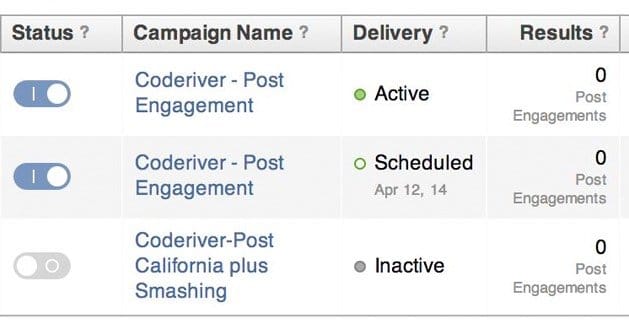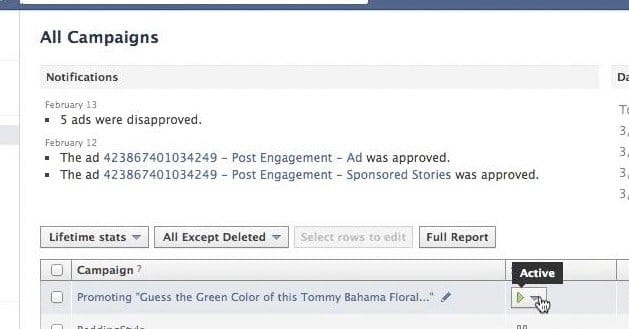 Written by ContentPowered.com
Written by ContentPowered.com
If you don’t know the ins and outs of the system, operating Facebook ads is a labyrinthine task. There are so many options and so many configurations that there are almost infinite possible failure points.
One of the most frustrating failures is not Facebook rejecting your ad. It’s not running your ad and getting untargeted, useless followers. It’s not even running an ad and seeing it underperform. The absolute worst is when you set an ad, everything looks fine, and it says “delivering” in the status for the ad. You check back a day or two later, only to find 0 views and 0 clicks. Your ad claims its delivering, but it’s clearly not. So what happened?
The Off Switch
An individual ad might say it’s delivering, but that’s only the status message for when your ad is turned on. Try clicking up to the ad set level and checking there. Is the ad set to run there as well? If yes, click up to the campaign level. There’s another off switch there, so if your campaign is turned off but your ads are turned on, they still read as on.
The reason for the triple layer off switch is to save settings when you need to adjust your ads on the fly. Say you have two campaigns, one that’s always running and one that’s time-sensitive for a holiday. Inside the holiday campaign, you have three ad sets, each with four ads inside them. That’s a total of 12 ads to be testing and running when the campaign is on.
As you run your holiday campaign, you adjust which ads run. You turn a few on, a few off, maybe disabling one ad set entirely. Then the holiday arrives and passes, your deals end, and you want to stop the ads.
To stop the ads, you have three options. You can go down and manually turn off all twelve ads. This works, but what happens if you want to restore your campaign later? You’d have to figure out which ads were turned off and which were running, which wastes time.
You can also delete the ads, but that’s not a great solution either. If you delete your ads, you can’t turn them back on later. They’re gone, they can’t be recovered, you just have to make them again if you change your mind. Facebook has a very high limit on saved ads, so it’s perfectly reasonable to have old ads disabled rather than deleted.
The best solution is to just turn off the campaign. That way, if you want to pick up where you left off, all you have to do is click one button. Unfortunately, that leads to cases where at the ad level, and even the ad set level, it looks like your ads are live. Only when you check campaign status do you notice they have been disabled.
The Bid Wars
Facebook ads are PPC. You want clicks, you pay for them. The more you pay, the more clicks you’ll get.
This is, of course, determined by a wide range of factors. The targeting you use – from demographic to interest to keyword – affects the cost of a given click. There’s a huge amount of writing available about the search for lower costs per click.
Searching for a lower cost per click is just a way of getting more clicks for the same budget. Very few marketers will lower their cost per click and then cut their advertising budget by that amount. Instead, they’ll take the money and reinvest in more clicks or another campaign.
When you set up Facebook ads, you set a maximum bid. This is a hard cap on the amount of money Facebook will spend on ads in a given period. You might have $1 CPC or $0.01 CPC, it won’t matter; once you spend up to your limit, Facebook cuts it off. There’s no judgment or analytics attached to determine whether cutting off is in your best interests.
This leads to a situation where you put in a maximum bid that’s fairly low. You might do this because you’ve managed a very low CPC, or you might do it because you’re running the ads on a limited basis and want to test how well they work before investing more. Either way, it’s a hard limit.
What happens, then, if Facebook can’t find anyone within your targeting that fits your budget? Your ad will say it’s delivering, but no one will see it.
One reason this happens is because of OCPM. This is Facebook’s optimized pay scheme, which dynamically determines which people are the best to see an ad, based on the objective of that ad. You might have one set of audience targeting factors, but within that audience, Facebook has ranked the users. Some users will be more likely to click an app, while others are more likely to like a page.
You optimize based on an objective, and Facebook will spend your advertising budget where it makes the most sense. Unfortunately, with a sufficiently low budget and a sufficiently limited target audience, you run into situations where the best users are the users that cost the most to reach. Facebook essentially gets caught in a failure loop; it doesn’t have enough budget to spend to reach the people you want to reach.
You can fix this by reverting to a regular bid scheme, or you can just increase your bid.
Narrow Targeting
Facebook has over a billion monthly active users, so it should be easy to get an audience no matter what your audience targeting may be, right? Well, that’s not really true. Sufficiently narrow targeting can leave your effective audience at zero. For example, what if you limit your targeting to Salt Lake City, you limit it to only Japanese speaking users, who are female, aged 60+, with two children, and who like The Simpsons. This is entirely possible within Facebook’s audience targeting, and it’s also entirely possible that there are people who fit that description.
The problems here are two-fold. First, what if those users don’t sign on? If the users aren’t there to be shown advertising, your ads won’t run. It’s also possible that those users don’t exist, and your targeting is too narrow. You will have to broaden it in order to reach anyone.


Nice post. And perfect explanations. Often valid. And it is indeed a tricky and labyrinthine task – well found 🙂 Now I’ve got one very nice case for you to dig into – an extremely annoying situation on my hands. And excuse me for the Dutch in the pic attached, but I am. Dutch. Not annoying, well, not all the time anyway. So. Here’s my story: none of the above are happening in my case. And my account IS being charged – 10-20 cents per hour active. Yes, I know, small numbers. I have ‘lost’ 2 bucks, not more than that. Yet, disregarding the amount, Facebook has had the meter running, yesterday and today, and my only ad says 0,00 spent. Still. Even stopped it and started a new campaign (targeting again for Page Likes), and the same thing happened. Slowly eating away the budget, but NOT actually spending it. Lol… HOW?!?!?! Any ideas?